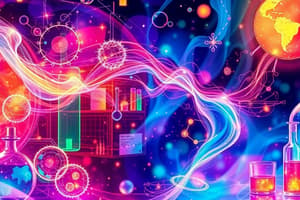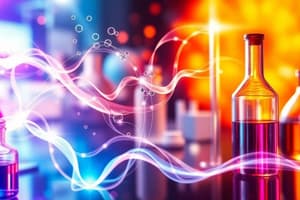Podcast
Questions and Answers
What is the primary difference between liquid chromatography and gas chromatography?
What is the primary difference between liquid chromatography and gas chromatography?
- Gas chromatography is more expensive than liquid chromatography.
- Liquid chromatography is used for chemical analysis, while gas chromatography is used for environmental testing.
- The stationary phase is contained in a column in gas chromatography, while it can be in a column or on a plane in liquid chromatography. (correct)
- Gas chromatography is more precise and accurate than liquid chromatography.
Which of the following is NOT a factor to consider when choosing an analytical method?
Which of the following is NOT a factor to consider when choosing an analytical method?
- The expected concentration range of the sample
- The cost of the assay and the entire analysis
- The color of the sample (correct)
- The type of readily available instrument
What is the most popular category of columnar liquid chromatography for chemical analysis?
What is the most popular category of columnar liquid chromatography for chemical analysis?
- Ion exchange chromatography
- High-performance liquid chromatography (HPLC) (correct)
- Thin-layer chromatography
- Size exclusion chromatography
Which of the following is NOT listed as a potential application of chemical analysis?
Which of the following is NOT listed as a potential application of chemical analysis?
What is the main purpose of a mobile phase in chromatography?
What is the main purpose of a mobile phase in chromatography?
Which of the following is the most important factor to consider when choosing an analytical method?
Which of the following is the most important factor to consider when choosing an analytical method?
Which of the following is NOT a signal source discussed in the text?
Which of the following is NOT a signal source discussed in the text?
What is the purpose of the flame in flame atomic emission spectroscopy?
What is the purpose of the flame in flame atomic emission spectroscopy?
Which statement about plasma is NOT true according to the text?
Which statement about plasma is NOT true according to the text?
Which type of plasma is described as the most important in the text?
Which type of plasma is described as the most important in the text?
What is the purpose of the burner head in flame atomic emission spectroscopy?
What is the purpose of the burner head in flame atomic emission spectroscopy?
How are arc and spark sources generated according to the text?
How are arc and spark sources generated according to the text?
What type of plasma is used in Direct Current Plasma (DCP) atomic emission spectroscopy?
What type of plasma is used in Direct Current Plasma (DCP) atomic emission spectroscopy?
Which part of the DCP instrument acts as a sample cell?
Which part of the DCP instrument acts as a sample cell?
What is the purpose of nebulization in DCP atomic emission spectroscopy?
What is the purpose of nebulization in DCP atomic emission spectroscopy?
Which of the following is NOT a type of sample preparation method mentioned in the text?
Which of the following is NOT a type of sample preparation method mentioned in the text?
What is the purpose of a monochromator in DCP atomic emission spectroscopy?
What is the purpose of a monochromator in DCP atomic emission spectroscopy?
Which of the following nebulizers is NOT mentioned in the text?
Which of the following nebulizers is NOT mentioned in the text?
What is the process that occurs simultaneously during a fluorescence measurement?
What is the process that occurs simultaneously during a fluorescence measurement?
What is the relationship used to calculate the concentration from the intensity of fluorescence?
What is the relationship used to calculate the concentration from the intensity of fluorescence?
Which type of fluorescence transition is most intense and useful for analytical determinations?
Which type of fluorescence transition is most intense and useful for analytical determinations?
In resonance fluorescence, how does the wavelength of emitted radiation compare to the absorbed radiation?
In resonance fluorescence, how does the wavelength of emitted radiation compare to the absorbed radiation?
What happens when a sample is introduced into a flame or other radiation source?
What happens when a sample is introduced into a flame or other radiation source?
What happens to atoms in an excited state?
What happens to atoms in an excited state?
What is the principle shared by all spectroscopic techniques?
What is the principle shared by all spectroscopic techniques?
When did the history of spectroscopy begin?
When did the history of spectroscopy begin?
What was the purpose of Joseph von Fraunhofer's experimental advances with dispersive spectrometers?
What was the purpose of Joseph von Fraunhofer's experimental advances with dispersive spectrometers?
What is the purpose of using spectroscopy as a tool?
What is the purpose of using spectroscopy as a tool?
What did Isaac Newton apply the word to describe?
What did Isaac Newton apply the word to describe?
What is the electromagnetic spectrum?
What is the electromagnetic spectrum?
Flashcards are hidden until you start studying




